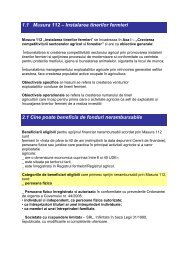2011 - Europe Direct Iasi
2011 - Europe Direct Iasi
2011 - Europe Direct Iasi
You also want an ePaper? Increase the reach of your titles
YUMPU automatically turns print PDFs into web optimized ePapers that Google loves.
EUROINVENT <strong>2011</strong><br />
4.50.<br />
A new method for calculation acceleration in medical<br />
Title<br />
applications of diffuse optical tomography<br />
Authors Tomasz GRZYWACZ, Jan SIKORA<br />
Electrotechnical Institute, Department of Electric<br />
Institution<br />
Traction, Warsaw, Poland<br />
Patent no. Pending<br />
DOT is an imaging modality with the aim to recover the spatial<br />
distribution of the optical parameters, such as absorption and<br />
scattering coefficients, and to present them as 3-D images to the<br />
clinician. The optical parameters are related to physiologically<br />
relevant properties of blood and tissue oxygenation levels.<br />
The use of near-infrared light for imaging is quite difficult since<br />
it is strongly scattered by tissue, unlike the radiation in CT,<br />
which generally travels in straight lines through the body.<br />
Diffuse light propagation complicates image reconstruction.<br />
Light travelling between two points on the surface spreads out<br />
over a significant volume inside the tissue and therefore carries<br />
very little spatial information. To maximise the information<br />
contained in the measurements, one uses multiple detectors to<br />
sample the light emerging over a large surface area from the<br />
body for each source.<br />
DOT problem is highly nonlinear, and analytical solutions exist<br />
only for a limited number of simple geometries. Previous<br />
Description numerical solutions of the forward problem in DOT were based<br />
on a finite element method (FEM) as well as various hybrid<br />
approaches combining FEM with stochastic methods. Our<br />
proposal is to combine BEM with domain decomposition<br />
methods in order to solve this problem. This two methods are<br />
complementary. The system of equations derived from BEM<br />
describes distribution of the state function over a particular area.<br />
BEM provides not only potential of the state function but also its<br />
normal derivative in each node of the area. This property makes<br />
BEM really convenient to cooperate with domain decomposition<br />
methods. They are based on transfering boundary conditions<br />
(Dirichlet, Neumann or mixed) between successive regions of<br />
the decomposed area. Authors applied algorithms from two main<br />
groups of domain decomposition methods: overlapping and nonoverlapping<br />
ones. A diffusion approximation of the light<br />
propagation model based on Helmholtz equation was solved in<br />
spherical geometry. The results show significant reduction in<br />
computation time while solving forward problem in DOT but<br />
only for huge problems.<br />
Class 4<br />
85
















